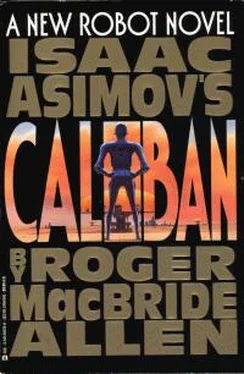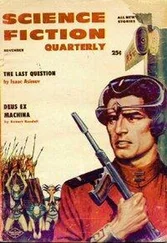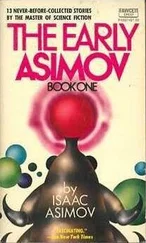Isaac Asimov - Caliban
Здесь есть возможность читать онлайн «Isaac Asimov - Caliban» весь текст электронной книги совершенно бесплатно (целиком полную версию без сокращений). В некоторых случаях можно слушать аудио, скачать через торрент в формате fb2 и присутствует краткое содержание. Год выпуска: 1997, ISBN: 1997, Издательство: Ace Books, Жанр: Фантастика и фэнтези, на английском языке. Описание произведения, (предисловие) а так же отзывы посетителей доступны на портале библиотеки ЛибКат.
- Название:Caliban
- Автор:
- Издательство:Ace Books
- Жанр:
- Год:1997
- ISBN:ISBN: 044-100482-2
- Рейтинг книги:4 / 5. Голосов: 1
-
Избранное:Добавить в избранное
- Отзывы:
-
Ваша оценка:
- 80
- 1
- 2
- 3
- 4
- 5
Caliban: краткое содержание, описание и аннотация
Предлагаем к чтению аннотацию, описание, краткое содержание или предисловие (зависит от того, что написал сам автор книги «Caliban»). Если вы не нашли необходимую информацию о книге — напишите в комментариях, мы постараемся отыскать её.
Caliban — читать онлайн бесплатно полную книгу (весь текст) целиком
Ниже представлен текст книги, разбитый по страницам. Система сохранения места последней прочитанной страницы, позволяет с удобством читать онлайн бесплатно книгу «Caliban», без необходимости каждый раз заново искать на чём Вы остановились. Поставьте закладку, и сможете в любой момент перейти на страницу, на которой закончили чтение.
Интервал:
Закладка:
With a start, she realized that the curtain had opened, that the audience was applauding the Governor politely—with a few boos from the back of the house—and that the Governor was well launched into her introduction. In fact, he was finishing up. Hells and heavens! How could her mind wander that much? Was it some aftereffect of the injury, or the treatment, or just a subconscious way of dealing with stage fright?
“…not expect you to agree with all she has to say,” Governor Grieg was saying. “There is much that I do not agree with myself. But I do believe that hers is a voice to which we must listen. I am convinced that her ideas—and the news she will relate—will have tremendous repercussions for us all. Ladies and gentlemen, please welcome Dr. Fredda Leving.” He turned toward her, smiling, leading the applause.
Not quite sure if it would not be wiser to cut and run for the stage wings and the side exit, Fredda stood up and walked toward the lectern. Chanto Grieg retreated back toward the table at the rear of the stage and took a seat next to Jomaine.
She was there, all alone. She stared out into the sea of faces and asked herself what madness had brought her to this place. But here she was, and there was nothing to do but move forward.
She cleared her throat and began to speak.
14
“THANK you, my friends,” Fredda began. “Tonight I intend to present an analysis of the Three Laws. However, before we launch into a detailed law-by-law examination, I think it would be wise to review some background information and focus our historical perspective.
“In my previous lecture, I presented arguments intended to establish that humans hold robots in low regard, that misuse and abuse of robots is degrading to both us and them, that we humans have allowed our own slothful reliance on robots to rob from us the ability to perform the most basic tasks. There is a common thread that holds all these problems together, a theme that runs through them all.
“It is the theme, ladies and gentlemen, of the Three Laws. They are at the core of all things involving robotics.”
Fredda paused for a moment and looked out over the audience, and happened to catch Alvar Kresh’s eye in the first row. She was startled to see the anger in his face. What had happened? Kresh was a reasonable man. What could have angered him so? Had some piece of news come to him? That possibility put a knot in her stomach. But never mind. Not now. She had to go on with the lecture.
“At the beginning of my previous lecture, I asked, ‘What are robots for?’ There is a parallel question: ‘What are the Three Laws for?’ What purpose are they meant to serve? That question startled me when I first asked it of myself. It was too much like asking, ‘What are people for?’ or ‘What is the meaning of life?’ There are some questions so basic that they can have no answer. People just are. Life just is. They contain their own meaning. We must make of them what we can. But as with robots themselves, the Laws, I would remind you once again, are human inventions, and were most certainly designed with specific purposes in mind. We can say what the Three Laws are for. Let us explore the question.
“Each of the Laws is based on several underlying principles, some overt and some not immediately evident. The initial principles behind all three Laws derive from universal human morality. This is a demonstrable fact, but the mathematical transformations in positronic positional notation required to prove it are of course not what this audience wishes to hear about. There are many days when I don’t wish to hear about such things myself.”
That line got a bit of a laugh. Good. They were still with her, still willing to listen. Fredda glanced to her notes, took a slightly nervous sip from her water, and went on. “Suffice to say that such techniques can be used to generalize the Three Laws such that they will read as follows: One, robots must not be dangerous; two, they must be useful; and three, they must be as economical as possible.
“Further mathematical transformation into the notation used by sociological modelers will show that this hierarchy of basic precepts is identical to a subset of the norms of all moral human societies. We can extract the identical concepts from any of the standard mathematically idealized and generalized moral social codes used by sociological modelers. These concepts can even be cast into a notation wherein each higher law overrides the ones below it whenever two come into conflict: Do no harm, be useful to others, do not destroy yourself.
“In short, the Three Laws encapsulate some ideals of behavior that are at the core of human morality, ideals that humans reach for but never grasp. That all sounds very comfortable and reassuring, but there are flaws.
“First, of necessity, the Three Laws are set down, burned into the very core of the positronic brain, as mathematical absolutes, without any grey areas or room for interpretation. But life is full of grey areas, places where hard-and-fast rules can’t work well, and individual judgment must serve instead.
“Second, we humans live by far more than three laws. Turning again toward results produced by mathematical modeling, it can be shown that the Three Laws are equivalent to a very good first-order approximation of idealized moral human behavior. But they are only an approximation. They are too rigid, and too simple. They cannot cover anything like the full range of normal situations, let alone serve in unusual and unique circumstances where true independent judgment must serve. Any being constrained by the Three Laws will be unable to cope with a wide range of circumstances likely to occur during a lifetime of contact with the available universe. In other words, the Three Laws render a being incapable of surviving as a free individual. Relatively simple math can demonstrate that robots acting under the Three Laws, but without ultimate human control, will have a high probability of malfunctioning if exposed to human-style decision situations. In short, the Three Laws make robots unable to cope unaided in an environment populated with anything much beyond other robots.
“Without the ability to deal in grey areas, without the literally thousands of internalized laws and rules and guidelines and rules of thumb that guide human decision making, robots cannot make creative decisions or judgment calls even remotely as complex as those we make.
“Aside from judgment, there is the problem of interpretation. Imagine a situation where a criminal is firing a blaster at a police officer. It is a given that the police officer should defend him- or herself, even to the use of deadly force. Society entitles—even expects—the police officer to subdue or even kill his attacker, because society values its own protection, and the officer’s life, over the criminal’s life. Now imagine that the officer is accompanied by a robot. The robot will of course attempt to shield the policeman from the criminal—but will likewise attempt to protect the criminal from the policeman. It will almost certainly attempt to prevent the police officer from firing back at the criminal. The robot will attempt to prevent harm to either human. The robot might step into the police officer’s field of fire, or let the criminal escape, or attempt to disarm both combatants. It might attempt to shield each from the other’s fire, even if that results in its own destruction and the immediate resumption of the gun battle.
“Indeed, we have run any number of simulations of such encounters. Without the robot present, the police officer can most often defeat the criminal. With a robot along, here are the outcomes more likely than the police winning: death of police officer and criminal with destruction of robot; death of police officer and with destruction of robot; destruction of robot coupled with escape of criminal; death of criminal and/or police officer with robot surviving just long enough to malfunction due to massive First Law/First Law and First Law/Second Law conflicts. In short, inject a robot into such a situation, and the odds are superb you will end up with a disaster.
Читать дальшеИнтервал:
Закладка:
Похожие книги на «Caliban»
Представляем Вашему вниманию похожие книги на «Caliban» списком для выбора. Мы отобрали схожую по названию и смыслу литературу в надежде предоставить читателям больше вариантов отыскать новые, интересные, ещё непрочитанные произведения.
Обсуждение, отзывы о книге «Caliban» и просто собственные мнения читателей. Оставьте ваши комментарии, напишите, что Вы думаете о произведении, его смысле или главных героях. Укажите что конкретно понравилось, а что нет, и почему Вы так считаете.







